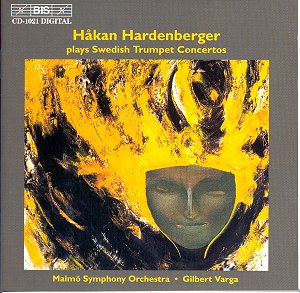Swedish Trumpet Concertos
Daniel BÖRTZ (b.1943) Trumpet Concerto
"Songs and Dances"
Jan SANDSTRÖM (b.1954) Trumpet Concerto
No. 2
Folke RABE (b.1935) Sardine
Sarcophagus
 Håkan Hardenberger
(trumpet)
Håkan Hardenberger
(trumpet)
Malmö Symphony Orchestra conducted by Gilbert Varga
 BIS BIS-CD-1021 [DDD
60:48]
BIS BIS-CD-1021 [DDD
60:48]
Crotchet
Amazon
UK AmazonUS CDNow

Håkan Hardenberger has steadily built a reputation for himself as one
of the world's leading trumpeters. He is one of a rare breed. A brass player
who makes his living by solo work alone. Like his compatriot, the trombonist
Christian Lindberg, Hardenberger has probably done more to further the solo
repertoire of his instrument than any other player with Takemitsu, Henze,
H K Gruber and Birtwistle amongst the many who have been inspired by him.
This disc features three diverse concertos written between 1994 and 1996
by fellow Swedes, all three of whom have had their works championed by
Hardenberger since their composition.
By far the best known name in this country is Jan Sandström who many
will know as a result of his numerous collaborations with Christian Lindberg
(anyone who enjoys Sandstrom's work on this disc should try his music for
trombone with Lindberg, also on BIS, it is Sandström at his best). His
Trumpet Concerto No. 2 is the most immediately accessible work of
the three, being outwardly tuneful in character, but none the less challenging
for it. In fact all three of these works challenge both performer and listener
in very different ways. Sandström's concerto takes us through a playful
first movement in which the most obvious influence is Stravinsky. Metrical
dance like rhythms are toyed with by the soloist, these being set against
a similarly dancing, predominantly pizzicato, accompaniment with subtle colouring
from the wind. The central slow movement (roughly half the tempo of the first)
makes very clear use of both the melodic and rhythmic material from the first
movement, albeit in a far more relaxed vein whilst the final movement is
a headlong dash for the finishing post with some impressive pyrotechnics
from the soloist. The booklet notes tell us that the concerto's composition
was closely associated with the composer's relationship with his then five
year old daughter and this clearly comes across in the sense of fun and humour
which is evident throughout. This is possibly not Sandström at his best
or most original but it is an enjoyable work which receives a committed
performance.
By contrast Folke Rabe's one movement concerto in all but name Sardine
Sarcophagus, is the most lyrical of the three and has the distinction
of having the most intriguing of titles. It owes its title primarily to the
fact that it was commissioned by the Music Factory, in the Norwegian city
of Bergen, which happens to be based in old sardine factory! The twist is
that in Seville every year a sardine is buried as part of the passion ritual.
However, Rabe cites Mahler as the main point of departure, in particular
Das Lied von der Erde, and this influence can be detected in the harmonic
references which are cleverly woven into the structure of the work. As in
the Sandström, the language is tonal and there are some particularly
haunting moments which linger in the memory although Rabe does not possess
a voice of originality. The composer has also had a close association with
Christian Lindberg and is a trombonist himself. His knowledge of the brass
medium is evident in the idiomatic writing for the soloist, which is the
most striking feature of the work.
The concerto by Daniel Börtz, subtitled Songs and Dances, is
the toughest of these works to get to grips with on a first hearing. Its
expressionist language is certainly more astringent than the works by
Sandström and Rabe, but upon repeated listening this is the work I found
most rewarding. Again Börtz does not have an immediately personal voice
but he does communicate directly with his audience. This is the first in
a series of four works by the composer which are linked to aspects of song
and Börtz manages to exploit the extremes of the instrument in terms
of range, dynamics and colour to a greater degree than either of the other
composers. Passages of technical virtuosity, at times reminiscent of the
great jazz style of trumpet playing, are well balanced with the more song
like material at the heart of the work. The slow movement is notably effective
in its use of the lowest register of the instrument, much of it muted, and
played with admirable ease by the soloist.
All in all then an interesting disc featuring three concertos which although
not the most musically memorable of works, demonstrate and communicate an
impressive understanding of the man and the instrument which inspired them.
The greatest impression is of the playing of Hardenberger himself. He is
totally at ease with this repertoire and I have heard few players over the
years with his sheer power and presence. The Malmö Symphony Orchestra
and Gilbert Varga provide well balanced accompaniment throughout.
Christopher Thomas
Performance and sound


